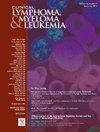JAK2、CALR或MPL与BCR::ABL1共突变骨髓增殖性肿瘤克隆关系的研究进展
IF 2.7
4区 医学
Q2 HEMATOLOGY
引用次数: 0
摘要
BCR: abl1阴性的骨髓增生性肿瘤(mpn)以JAK2、CALR或MPL突变为特征。通常这些突变相互排斥,也排斥BCR::ABL1。我们回顾了177例JAK2、CALR或MPL和BCR::ABL1突变的克隆相互作用,包括JAK2/BCR::ABL1 (N = 142)、CALR/BCR::ABL1 (N = 31)、MPL/BCR::ABL1 (N = 3)。共突变可以发生在同一克隆或不同亚克隆中。在这篇综述中,我们使用克隆数据、突变测序和治疗反应评估来解决这个问题。我们发现在JAK2/BCR::ABL1共突变的受试者中存在复杂的分支克隆进化。相反,在CALR/BCR::ABL1的受试者中,共突变发生在不同的亚克隆中。MPL/BCR::ABL1患者的数据太少,无法进行批判性分析。然而,评估克隆性的间接方法限制了我们的结论。了解具有共突变的mpn的克隆结构是了解潜在生物学和给予适当治疗的必要条件。本文章由计算机程序翻译,如有差异,请以英文原文为准。
A Review of Clonal Relationships in Myeloproliferative Neoplasms With Co-Mutations of JAK2, CALR or MPL and BCR::ABL1
BCR::ABL1-negative myelo-proliferative neoplasms (MPNs) are characterized by mutations in JAK2, CALR, or MPL. Usually these mutations are co-exclusive of each other and of BCR::ABL1. We reviewed clonal interactions in 177 subjects with mutations in JAK2, CALR, or MPL and BCR::ABL1 including JAK2/BCR::ABL1 (N = 142), CALR/BCR::ABL1 (N = 31), MPL/BCR::ABL1 (N = 3). Co-mutations can arise in the same clone or in different sub-clones. In this review we used clonality data, mutation sequencing and therapy response evaluation to address this question. We found that in subjects with JAK2/BCR::ABL1 co-mutations there is a complex, branched clonal evolution. In contrast, in subjects with CALR/BCR::ABL1, co-mutations are in different sub-clones. There are too few data in subjects with MPL/BCR::ABL1 to critically analyze. However, indirect methods for assessing clonality limit our conclusions. Understanding clonal architecture of MPNs with co-mutations is needed to understand the underlying biology and give appropriate therapy.
求助全文
通过发布文献求助,成功后即可免费获取论文全文。
去求助
来源期刊

Clinical Lymphoma, Myeloma & Leukemia
ONCOLOGY-HEMATOLOGY
CiteScore
2.70
自引率
3.70%
发文量
1606
审稿时长
26 days
期刊介绍:
Clinical Lymphoma, Myeloma & Leukemia is a peer-reviewed monthly journal that publishes original articles describing various aspects of clinical and translational research of lymphoma, myeloma and leukemia. Clinical Lymphoma, Myeloma & Leukemia is devoted to articles on detection, diagnosis, prevention, and treatment of lymphoma, myeloma, leukemia and related disorders including macroglobulinemia, amyloidosis, and plasma-cell dyscrasias. The main emphasis is on recent scientific developments in all areas related to lymphoma, myeloma and leukemia. Specific areas of interest include clinical research and mechanistic approaches; drug sensitivity and resistance; gene and antisense therapy; pathology, markers, and prognostic indicators; chemoprevention strategies; multimodality therapy; and integration of various approaches.
 求助内容:
求助内容: 应助结果提醒方式:
应助结果提醒方式:


